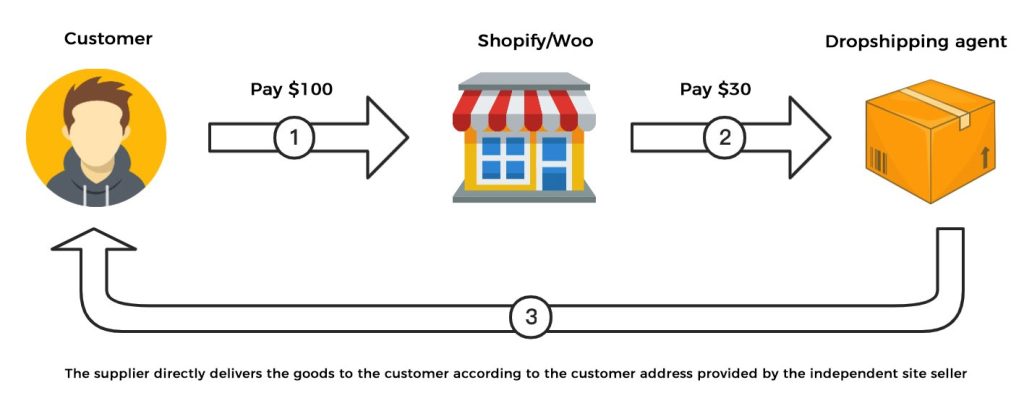Dropshipping has emerged as a game-changing business model for aspiring entrepreneurs, offering a low-cost entry into the e-commerce world. As of July 07, 2025, with the global dropshipping market projected to exceed $370 billion, this model allows sellers to operate without inventory, making it ideal for beginners. But how can you start dropshipping with minimal or no upfront investment? This comprehensive guide explores what dropshipping is, its step-by-step process, pros and cons, product selection strategies, cost control techniques, and how DSFulfill, a free Dropshipping ERP, can enhance your journey.
What is Dropshipping?
Dropshipping is a supply chain management method that enables sellers to market and sell products without holding inventory. In this model, once a seller receives an order, they forward the details to a supplier, who ships the product directly to the customer. The seller acts as an intermediary, handling marketing, customer inquiries, and complaints, while the supplier manages production, inventory, and delivery. This approach eliminates the need for warehousing or stock management, lowering the entrepreneurial barrier. Key players include the supplier, seller, and customer. With over 30% of online stores in North America adopting dropshipping, its popularity continues to soar due to benefits like minimal upfront costs, no inventory risk, and streamlined order fulfillment.

The Dropshipping Process Step-by-Step
1. Set Up Your Online Store
Choose a suitable platform to launch your store. Popular cross-border options include AliExpress, Amazon, Shopee, and independent sites like Shopify, WordPress, or WooCommerce. Tools like FindNiche can help identify trending products and platforms based on regional demand, guiding your store setup for maximum reach.
2. Customer Places an Order
Selecting reliable products is crucial. Prioritize suppliers with proven track records, such as those you’ve collaborated with before. If new, source from AliExpress or 1688, using FindNiche to assess seller ratings and sales volumes. High-rated suppliers reduce fulfillment risks.
3. Seller Requests Shipment from Supplier
Promptly notify your supplier of the order and update your store’s shipping status. Utilize sourcing tools to automate and monitor real-time fulfillment, ensuring accuracy from the outset.
4. Supplier Ships the Order
Supplier reliability varies, so track shipment timeliness and verify product authenticity and availability. Regular communication with suppliers is essential to mitigate inconsistencies.
5. Seller Manages After-Sales Support
After-sales service, a common pain point, depends on product quality and supplier reliability. Effective product selection and supplier vetting—supported by tools like FindNiche—can minimize issues, ensuring a smoother customer experience.
Pros and Cons of Dropshipping
Advantages
- No Inventory Risk: Eliminates the need for upfront stock, reducing financial pressure.
- Location Flexibility: Operate from anywhere with an internet connection.
- Category Versatility: Sell across diverse product lines without specialization.
- Rapid Scaling: Expand your business quickly without logistical constraints.
Disadvantages
- Unstable Suppliers: Inconsistent fulfillment can lead to customer disputes.
- Transparent Pricing: Low profit margins due to visible product costs.
- Lack of Brand Loyalty: Difficulty retaining customers without a strong brand.
- Platform Restrictions: Strict rules from e-commerce platforms can limit operations.
Dropshipping Product Selection Strategies
- Target High-Demand, Profitable Niches: Analyze market trends and consumer needs using data tools to identify products with growth potential and competitive margins.
- Self-Assessment: Understand your resources and skills, avoiding overambitious ventures early on.
- Prioritize Quality and Supplier Credibility: Use historical sales and ratings as benchmarks; consider in-person supplier visits if feasible.
- Focus on Unique, Market-Accepted Products: Opt for items blending red-ocean popularity with blue-ocean uniqueness, or unique products with a competitive edge.
- Optimize Logistics Speed and Service: Fast, reliable shipping boosts store rankings and repeat customers—track logistics diligently.
- Leverage Data and Trends: Use selection tools and real-time analytics to refine choices, employing data funnels for commercial success.
Cost Control Techniques for Dropshipping
Product Cost Management
The lack of inventory makes cost control challenging, especially with transparent pricing. Keep product costs below 25% of the selling price by negotiating competitive rates with suppliers to secure healthy profit margins.
Logistics Cost Management
Limit logistics costs to under 10% by negotiating favorable shipping rates with partners, reducing the overall cost per order.
Marketing Cost Management
Cap marketing expenses at 40% to ensure a strong return on investment (ROI), optimizing ad budgets with targeted campaigns.
Other Cost Management
Control additional costs (e.g., platform fees, credit card charges) to under 5% by carefully managing fees, keeping total expenses within a reasonable range.
Effective cost control across these areas enhances profitability, making dropshipping a viable low-cost business model.
How DSFulfill Elevates Low-Cost Dropshipping
DSFulfill, a free Dropshipping ERP, is designed to support beginners and small teams in launching and managing a dropshipping business with minimal investment. It automates key processes—product sourcing, order fulfillment, and cost tracking—reducing the need for expensive tools or staff. Features include:
- Multi-Platform Integration: Connects with Shopify, WooCommerce, and more, aligning with your store setup.
- Automated Sourcing: Simplifies supplier coordination from AliExpress and 1688.
- Cost Management Tools: Tracks product, logistics, and marketing costs to stay within budget.
- Mobile Accessibility: Supports over 60% mobile e-commerce traffic, ensuring flexibility.
By leveraging DSFulfill, you can start dropshipping with zero upfront costs, focusing on growth rather than operational overhead.
SEO Tips for Dropshipping Success
- Keyword Optimization: Use “low-cost dropshipping,” “Dropshipping 2025,” and “DSFulfill ERP” in your store content and blogs.
- Mobile-Friendly Design: Optimize your site for mobile users to improve rankings.
- Content Authority: Share guides or videos on cost-effective dropshipping with DSFulfill to build trust and visibility.
Conclusion
Starting dropshipping with low or no cost is achievable in 2025, thanks to its inventory-free model and tools like DSFulfill. By setting up a store, selecting reliable products, managing costs effectively, and leveraging a free ERP, you can enter the $370 billion dropshipping market with confidence. Begin your journey with DSFulfill today and turn your e-commerce dreams into a profitable reality!


